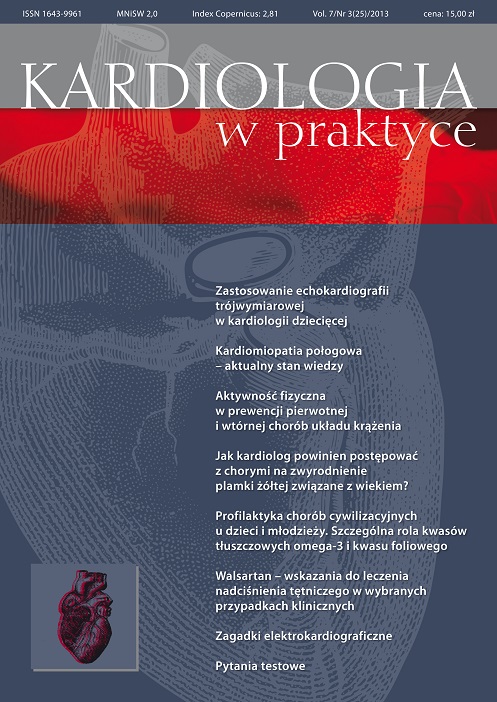Valsartan – indications for therapy of arterial hypertension in selected clinical cases Case report
Main Article Content
Abstract
Valsartan is representative of the AT1 receptor antagonists for angiotensin II. It is characterized by high clinical efficacy in the treatment of hypertension as monotherapy and in combination therapy. It assures the 24 hour control of blood pressure and is very well tolerated
Downloads
Article Details

This work is licensed under a Creative Commons Attribution-NonCommercial-NoDerivatives 4.0 International License.
Copyright: © Medical Education sp. z o.o. This is an Open Access article distributed under the terms of the Attribution-NonCommercial 4.0 International (CC BY-NC 4.0). License (https://creativecommons.org/licenses/by-nc/4.0/), allowing third parties to copy and redistribute the material in any medium or format and to remix, transform, and build upon the material, provided the original work is properly cited and states its license.
Address reprint requests to: Medical Education, Marcin Kuźma (marcin.kuzma@mededu.pl)
References
2. Della Chiesa A., Pfiffner D., Meier B. et al.: Sexual activity in hypertensive men. J. Hum. Hypertens. 2003; 17(8): 515-21.
3. Julius S., Kjeldsen S.E., Weber M. et al.; VALUE trial group: Outcomes in hypertensive patients at high cardiovascular risk treated with regimens based on valsartan or amlodipine: the VALUE randomised trial. Lancet 2004; 363(9426): 2022-31.
4. Malacco E., Santonastaso M., Varì N.A. et al.: Comparison of valsartan 160 mg with lisinopril 20 mg, given as monotherapy or in combination with a diuretic, for the treatment of hypertension: the blood pressure reduction and tolerability of valsartan in comparison with lisinopril (PREVAIL) study. Clin. Ther. 2004; 26(6): 855-65.
5. Mochizuki S., Dahlöf B., Shimizu M. et al.; Jikei Heart Study group: Valsartan in a Japanese population with hypertension and other cardiovascular disease (Jikei Heart Study): a randomised, open-label, blinded endpoint morbidity-mortality study. Lancet 2007; 369(9571): 1431-9.
6. McMurray J.J., Holman R.R., Haffner S.M. et al.; The NAVIGATOR Study Group: Effect of valsartan on the Incidence of diabetes and cardiovascular events. N. Engl. J. Med. 2010; 362: 1477-1490.
7. Ogihara T., Saruta T., Rakugi H. et al.: Target blood pressure for treatment of isolated systolic hypertension in the elderly: valsartan in elderly isolated systolic hypertension study. Hypertension 2010; 56: 196-202.
8. Ruilope L.M., Malacco E., Khder Y. et al.: Efficacy and tolerability of combination therapy with valsartan plus hydrochlorothiazide compared with amlodipine monotherapy in hypertensive patients with other cardiovascular risk factors: the VAST study. Clin. Ther. 2005; 27(5): 578-87.
9. Sawada T., Yamada H., Dahlof B. et al.: Effects of valsartan on morbidity and mortality in uncontrolled hypertensive patients with high cardiovascular risks: KYOTO HEART Study. Eur. Heart J. 2009; 30: 2461-2469.
10. Widecka K., Grodzicki T., Narkiewicz K. et al.: Zasady postępowania w nadciśnieniu tętniczym – 2011 rok. Wytyczne Polskiego Towarzystwa Nadciśnienia Tętniczego. Nadciśnienie Tętnicze 2011; 15: 211-235.

